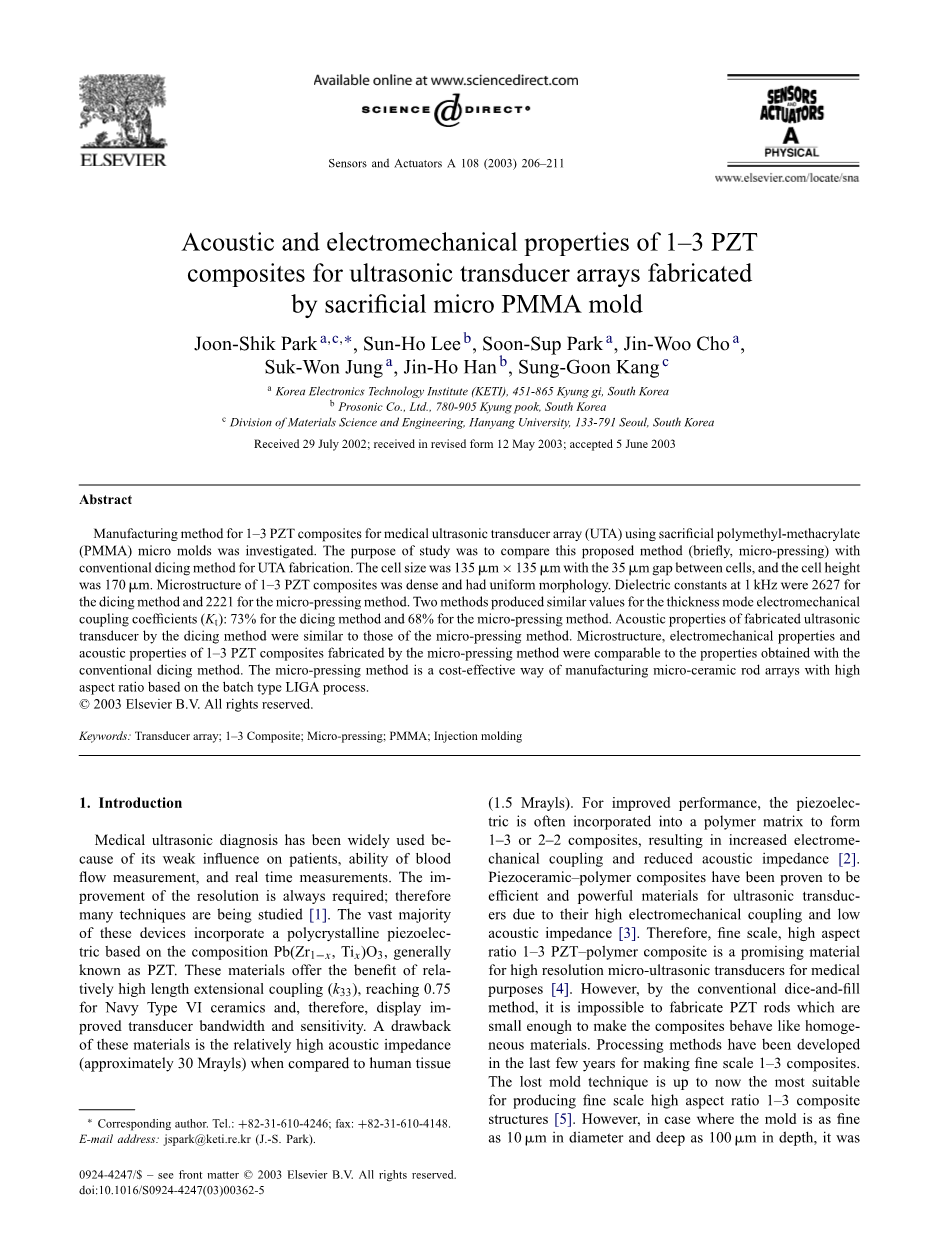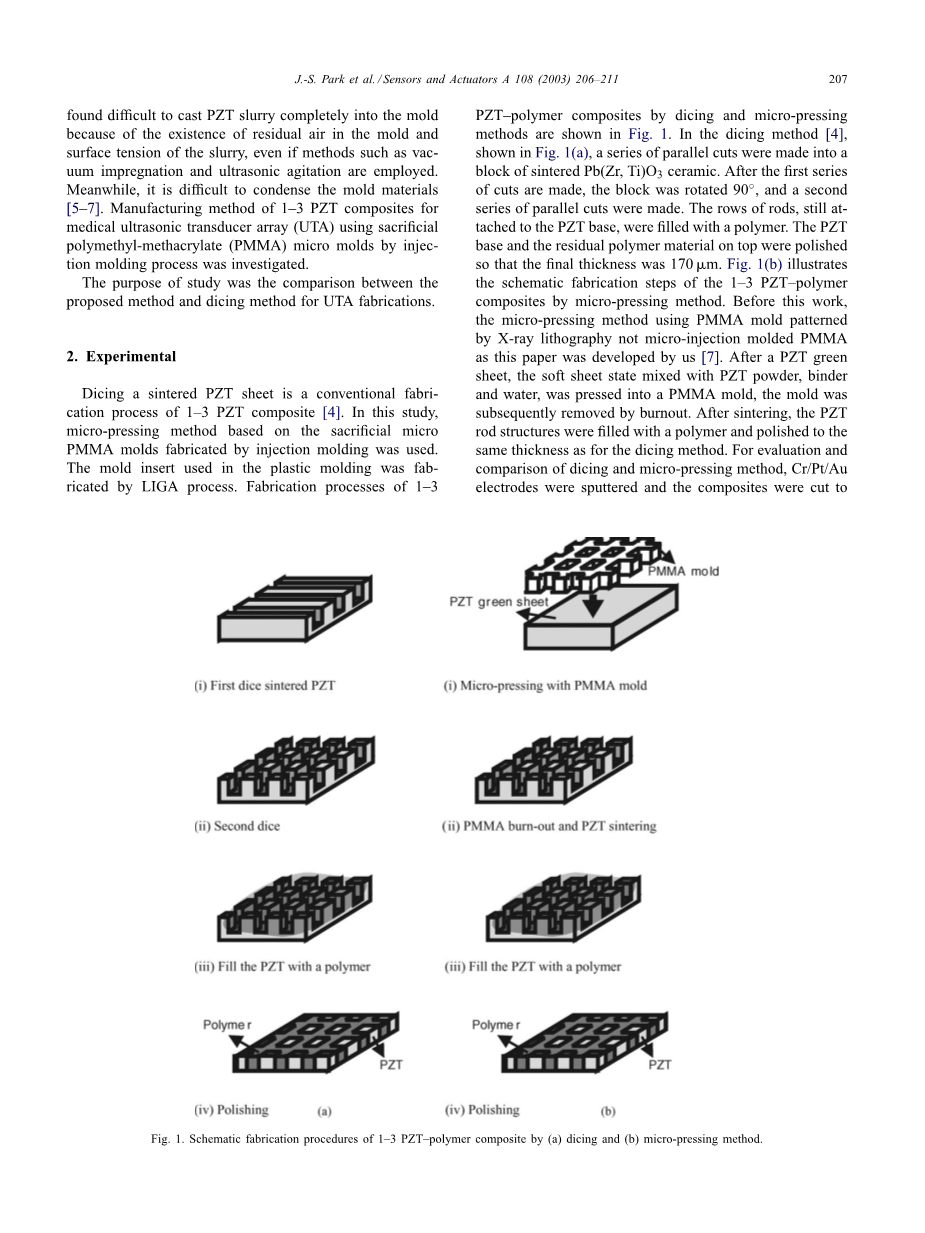

英语原文共 6 页,剩余内容已隐藏,支付完成后下载完整资料
Acoustic and electromechanical properties of 1–3 PZT composites for ultrasonic transducer arrays fabricated by sacrificial micro PMMA mold
用牺牲微PMMA模的方法制造的超声波换能器阵列的声学和机电特性
Abstract
Manufacturing method for 1–3 PZT composites for medical ultrasonic transducer array (UTA) using sacrificial polymethyl-methacrylate (PMMA) micro molds was investigated. The purpose of study was to compare this proposed method (briefly, micro-pressing) with conventional dicing method for UTA fabrication. The cell size was 135mu;m times; 135mu;m with the 35mu;m gap between cells, and the cell height was 170m. Microstructure of 1–3 PZT composites was dense and had uniform morphology. Dielectric constants at 1 kHz were 2627 for the dicing method and 2221 for the micro-pressing method. Two methods produced similar values for the thickness mode electromechanical coupling coefficients (Kt): 73% for the dicing method and 68% for the micro-pressing method. Acoustic properties of fabricated ultrasonic transducer by the dicing method were similar to those of the micro-pressing method. Microstructure, electromechanical properties and acoustic properties of 1–3 PZT composites fabricated by the micro-pressing method were comparable to the properties obtained with the conventional dicing method. The micro-pressing method is a cost-effective way of manufacturing micro-ceramic rod arrays with high aspect ratio based on the batch type LIGA process.
Keywords: Transducer array; 1–3 Composite; Micro-pressing; PMMA; Injection molding
摘要:
本文研究了以牺牲聚甲基丙烯酸甲酯(PMMA)微型模具的方法制备医用超声波换能器阵列(UTA)1-3 PZT复合材料。研究目的是将该法(简称为微压法)与用于UTA制造的常规切割方法进行比较。微型模具大小为135mu;mtimes;135mu;m,微型模具间隙为35mu;m,微型模具高度为170mu;m。 1-3 PZT复合材料的微观结构致密,形态均匀。1kHz时,切割法的介电常数为2627,微压法的介电常数为2221。两种方法得到的厚度模式机电耦合系数(Kt)值相近——切割法为73%,微压法为68%。通过切割法制造的超声换能器的声学特性与微压法相似,并且微压法制备的1-3 PZT复合材料的微结构,机电性能和声学性能也与用常规切割方法获得的性能相当。微压法是一种基于LIGA工艺制造批量生产的,经济有效且具有高纵横比的微型陶瓷棒阵列的方法。
关键词:传感器阵列;1-3复合材料;微压法;聚甲基丙烯酸甲酯;注塑成型。
1.Introduction
Medical ultrasonic diagnosis has been widely used because of its weak influence on patients, ability of blood flow measurement, and real time measurements. The improvement of the resolution is always required; therefore many techniques are being studied [1]. The vast majority of these devices incorporate a polycrystalline piezoelectric based on the composition Pb(Zr1minus;x, Tix)O3, generally known as PZT. These materials offer the benefit of relatively high length extensional coupling (k33), reaching 0.75 for Navy Type VI ceramics and, therefore, display improved transducer bandwidth and sensitivity. A drawback of these materials is the relatively high acoustic impedance (approximately 30 Mrayls) when compared to human tissue (1.5 Mrayls). For improved performance, the piezoelectric is often incorporated into a polymer matrix to form 1–3 or 2–2 composites, resulting in increased electromechanical coupling and reduced acoustic impedance [2]. Piezoceramic–polymer composites have been proven to be efficient and powerful materials for ultrasonic transducers due to their high electromechanical coupling and low acoustic impedance [3]. Therefore, fine scale, high aspect ratio 1–3 PZT–polymer composite is a promising material for high resolution micro-ultrasonic transducers for medical purposes [4]. However, by the conventional dice-and-fill method, it is impossible to fabricate PZT rods which are small enough to make the composites behave like homogeneous materials. Processing methods have been developed in the last few years for making fine scale 1–3 composites. The lost mold technique is up to now the most suitable for producing fine scale high aspect ratio 1–3 composite structures [5]. However, in case where the mold is as fine as 10mu;m in diameter and deep as 100mu;m in depth, it was found difficult to cast PZT slurry completely into the mold because of the existence of residual air in the mold and surface tension of the slurry, even if methods such as vacuum impregnation and ultrasonic agitation are employed. Meanwhile, it is difficult to condense the mold materials [5–7]. Manufacturing method of 1–3 PZT composites for medical ultrasonic transducer array (UTA) using sacrificial polymethyl-methacrylate (PMMA) micro molds by injection molding process was investigated.
The purpose of study was the comparison between the proposed method and dicing method for UTA fabrications.
1.概述
由于对患者的影响小,能测量血流量和能进行实时测量,医疗超声诊断得到了广泛应用。科技总是不断进步的,因此,许多技术正不断被研究【1】。这些设备绝大多数包含一个由Pb(Zr1minus;x, Tix)O3(PZT)的多晶压电体。这些材料提供了相对高长度的拉伸耦合(k33)能力的优点,达到了0.75的海军型VI陶瓷,因此,展示了传感器带宽和灵敏度的改进。但和人体组织相比较,这些材料的缺点是有相对较高的声阻抗(大约30个Mrayls,人体约1.5个)。为了提高性能,压电体经常被插入到聚合物中以形成1-3或2-2的复合材料,从而增加机电耦合能力并减小声阻抗[2]。由于其高机电耦合能力和低声阻抗,压电陶瓷聚合物复合材料已经被证明是超声波换能器的高效材料[3]。因此,尺寸合适,高纵横比的1-3 PZT-聚合物复合材料是用于医疗用途的高分辨率微超声换能器的极具前景的材料[4]。然而,采用传统的双填充法,不可能制备出足够小且使复合材料表现均匀的PZT杆。在过去的几年里,已经开发出了1-3复合材料的加工方法。目前生产1-3复合材料的技术就是牺牲模具法[5]。然而,即使使用真空浸渍和超声波搅拌等方法,在模具的直径为10mu;m,深度为100mu;m深的情况下,由于模具中残留空气的存在和浆料的表面张力,也难以将PZT浆料完全浇铸到模具中。同时,压缩模具材料也是一大难题[5-7]。本文研究了以牺牲聚甲基丙烯酸甲酯(PMMA)微型模具并通过注塑成型的工艺来制备1-3 PZT复合材料将之用于医用超声波换能器阵列(UTA)的方法。
2. Experimental
Dicing a sintered PZT sheet is a conventional fabrication process of 1–3 PZT composite [4]. In this study, micro-pressing method based on the sacrificial micro PMMA molds fabricated by injection molding was used. The mold insert used in the plastic molding was fabricated by LIGA process. Fabrication processes of 1–3 PZT–polymer composites by dicing and micro-pressing methods are shown in Fig. 1. In the dicing method [4], shown in Fig. 1(a), a series of parallel cuts were made into a block of sintered Pb(Zr, Ti)O3 ceramic. After the first series of cuts are made, the block was rotated 90◦, and a second series of parallel cuts were made. The rows of rods, still attached to the PZT base, were filled with a polymer. The
剩余内容已隐藏,支付完成后下载完整资料
资料编号:[141113],资料为PDF文档或Word文档,PDF文档可免费转换为Word
您可能感兴趣的文章
- 播撒生物炭促进鸟粪石形成,但加速重金属积累外文翻译资料
- 钢铁工业余热有机朗肯发电的能量及炯分析外文翻译资料
- 深度共晶溶剂微波辅助处理木质素-碳水化合物复合 物的高效裂解及超快提取木质素低聚物外文翻译资料
- 功能化杯状芳烃离子团族[4]的合成、晶体结构及竞争结合性能外文翻译资料
- 面向高能量密度柔性超级电容器的无纺布用黑磷杂化微纤维的微流控纺丝结构外文翻译资料
- 活性炭对水溶液中氨的吸附外文翻译资料
- 制备可控海胆状NiCo2S4微球协同硫掺杂石墨烯作为高性能 二次锌空气电池的双功能催化剂外文翻译资料
- 钛酸盐材料对重金属离子的吸附外文翻译资料
- CO2敏感催化剂的合成与表征温度响应催化聚离子液体微凝胶外文翻译资料
- 温度响应微凝胶薄膜在湿环境中作为可逆二氧化碳吸收剂外文翻译资料


